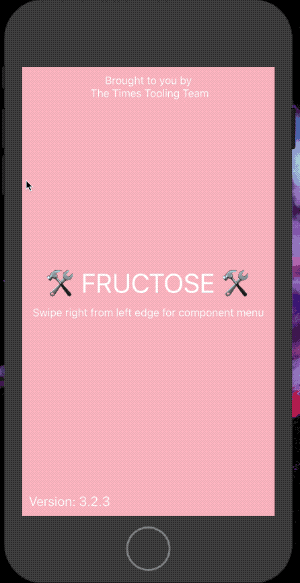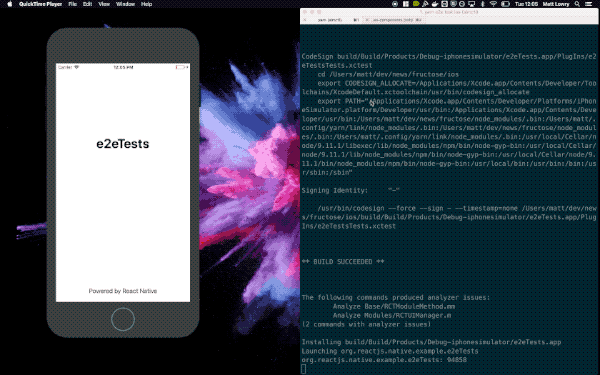Fructose - Functional React (native) UI Tester
Brought to you by The Times Tooling team 🛠
Fructose is a testing library that enables the loading of react native and react native web components on a device.
We have used this to
- Enable automated functional black and grey box testing of components.
- Enable automated visual regression of components with Dextrose
Swipe right to see the component list and manually load a component
Overview
Fructose has 3 components:
The App
The Fructose app allows for the loading of arbitrary components at runtime. Once the app is started you are able to load the components in either manual or automated fashions.
The Server
The fructose server is how we proxy commands from the client to the app via websockets.
The Client
The fructose client is how we communicate to the server via websockets
Getting Started
We are actively working on this to become easier.
Running and understanding the examples
The best way to see what fructose does is to run the end to end tests.
Running
From the root of the project run yarn and then either...
yarn e2e:test:web
yarn e2e:test:ios
yarn e2e:test:android
You will need a (simulator | emulator | chrome) to run these examples.
Understanding the examples
In the e2e Test folder you will find examples of how to consume fructose.
We suggest first looking at the scripts folder to understand the steps required for running tests with Fructose.
Then look at the examples folder.
The .showcase file is a description of how a component should be rendered.
Showcase files came around because originally fructose consumed storybook files. This eventually resulted in numerous issues so we created an abstraction layer which decouples components from storybook.
You can see a working example of how showcase to storybook works here.
Showcase files are then loaded into the app index via react-native-showcase-loader function.
The test file is an example of how to load a component ready for grey or black box testing.
Finally, the fructose folder is where all of the different platform indexes live.
Below are examples of iOS and Web e2eTests running and asserting that the app emits the component has loaded:
React Native Web
React Native IOS
(The red screen is expected as we're catching a component that errors)
(Yes the tests are asserting that quick)
Consuming Fructose
From your project
yarn add @times-components/fructose --dev
yarn add react-native-showcase-loader --dev
Create a folder fructose in your project root directory.
Create an index.*.js in this folder for your platform of choice: ios, android, or web.
Register the component to the name that your app binary expects.
Use react native showcase loader function to require in your showcase files.
See the examples below:
Writing tests
In a before, hook import setup from fructose and await on.
fructose.hooks.mobile.setup();
fructose.hooks.web.setup();
Once the setup promise resolves a fructoseClient. Use this client to tell your app to load components defined in your showcase files.
fructoseClient.loadComponent('your component name')
Your component is now ready for interrogation by the testing library of your choice. We have successfully used both appium and detox
Notes
We currently have Fructose running in a CI environment with...
- jest as the test runner.
- detox is being used as the driver for IOS. If you want to understand expect, element, and by, take a look at the Detox documentation.
- chromeless is being used as the driver for the web component tests
Future
- Fructose cli to initialise and run tests


